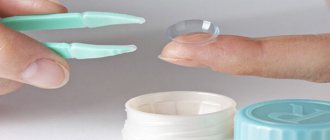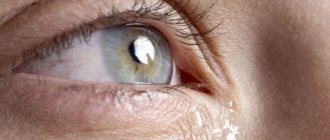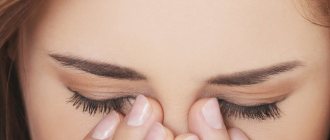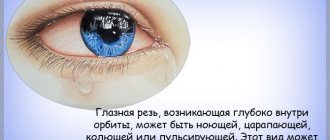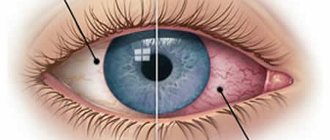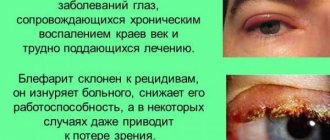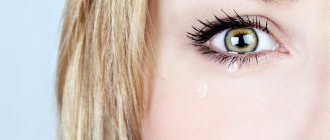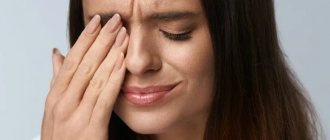From this article you will learn:
- What causes watery eyes in older people?
- How to treat excessive tearing in older people
- How to properly put drops into the eyes for watery eyes in older people
- What folk remedies help with lacrimation in older people
From a physiological point of view, lacrimation is a natural process. The secretion of tears is necessary to cleanse the conjunctival canals. A more intense process is observed when a piece of dirt or other foreign object gets on the mucous membrane. All these are processes and reactions characteristic of the body. However, lacrimation in older people can occur for no apparent reason, and the process often lasts quite a long time. In this article we will tell you how lacrimation in older people is treated.
What is lacrimation
In the language of terms, lacrimation is the active secretion of fluid by the lacrimal glands. It can be dictated by natural processes in the body, or it can alert about any disease. The production of tears is common to people of any age.
The physiological function of lacrimation is to moisturize the conjunctiva and cornea and protect the eyes from dirt. Tear fluid removes small objects that irritate the mucous membrane. The lacrimal glands are located in the recess of the frontal bone, more precisely, in the outer part of the orbit. Tears are 98% water. The remaining 2% is sodium, chlorine, potassium, organic acids, protein, mucus and lysozyme (a special enzyme that protects the mucous membrane from infection). In both young and old people, lacrimation occurs continuously. A tear collects in a lake of tears. Then it passes through special canaliculi into the lacrimal sac, and from there along the nasolacrimal duct into the nose. Lacrimation can be divided into two groups: physiological and emotional (under the influence of emotions of happiness or pain).
If elderly people experience excessive lacrimation, it may be retention (associated with disruption of the lacrimal ducts) or hypersecretory (excessive function of the lacrimal glands). If this problem occurs in an elderly person, the skin under the eyes sag and the lower eyelid droops. Due to the blocking of the opening, tear fluid begins to accumulate. All these symptoms describe senile blepharoptosis. Watery eyes in older people require special treatment. Therapy is selected depending on the problem itself.
Read the material on the topic: How to prevent vision deterioration in older people
Features of the pathology
The secretion of tear fluid is a natural physiological process. The eye structures contain special glands that produce tears. This process is constant and continuous (provided there are no pathologies). During physiological lacrimation, very little fluid is produced; it performs important functions for the visual apparatus:
- moisturizes the cornea and lens, which ensures a clear picture;
- washes away particles of dust, debris, microbes settling on the surface of the eyeball;
- protects against the penetration of pathogenic microorganisms into the eye structures.
In this case, medicated eye drops to reduce tearing are not needed. But if any ophthalmological disease develops, the eyes often begin to water more, irritation and swelling appear. There are two types of pathological lacrimation:
- Retention, caused by dysfunction of the lacrimal ducts. This problem often occurs in old age, but it can also be congenital.
- Hypersecretory, that is, caused by excessive work of the lacrimal glands.
Before purchasing anti-lacrimation eye drops, you need to find out the cause of the unpleasant symptom. Computer eye drops
- Corticosteroids - contain hormones and are used for severe forms of inflammation, infections, allergies, accompanied by increased lacrimation. Such drops will quickly relieve itching, discomfort, swelling, and stop lacrimation, but at the same time they have a number of contraindications, so they are prescribed only in extreme cases when other medications have not given the desired effect.
- Antibacterial - aimed at destroying bacteria as the root cause of intense lacrimation. They are prescribed if it is clearly established that the cause of the unpleasant symptom is a bacterial infection.
- Vasoconstrictors - are used if tears are released due to eye strain, increased intraocular pressure, for example, during prolonged work at the computer.
- Antihistamines are used to treat allergies of various origins and their symptoms. They quickly relieve itching, irritation, swelling and tearing, and often contain an additional antibacterial or anti-inflammatory component. Anti-allergenic eye drops act almost instantly, but not for long, so it is imperative to detect and eliminate the allergen.
There are several types of medications for watery eyes. They should be dripped several times a day, although some of them have a prolonged effect, so the procedures are carried out only 1-2 times a day:
Antihistamines. Prescribed for allergies, they block the production of histamine, thereby eliminating allergy symptoms. Such drops are often prescribed to people who suffer from seasonal allergies caused by flowering vegetation. Anti-inflammatory. Helps quickly eliminate swelling and inflammation. Prescribed for a number of eye diseases that occur with severe redness of the conjunctiva and swelling of the eyelids. Antibacterial. Such medications are prescribed if lacrimation is caused by an infectious disease. The attending physician selects such drugs based on the results of bacterial culture from the visual organs
It is important that the medicine is active against pathogens. Prophylactic drops. Necessary for insufficient production of tear fluid
Artificial tear preparations are well suited for patients of all age groups. Combined drugs. Such medications help eliminate several eye problems at the same time. They moisturize the eyes and reduce inflammation.
In some cases, excessive tearing from the eyes is caused by improper selection or use of contact lenses. In this case, artificial tear preparations are prescribed to moisturize the eyes and eliminate irritation.
Causes of watery eyes in older people
Watery eyes in older people can be caused by two factors: improper drainage of tear fluid or its excess.
Both situations are a sign of some disorder or illness. But if these symptoms are the only thing that bothers the old man, then the reason is probably severe overwork. However, in young people, eye fatigue occurs more often, but excess tearing does not bother them. This fact is explained by the fact that people aged 45–50 years and older experience natural age-related changes in the tissues and systems of the body. The aging process is accompanied by thinning of the tear film, impaired patency of the lacrimal canaliculi and weakening of the eye muscles. In this regard, a more acute reaction to various deviations is observed. With eye diseases, lacrimation in older people will be more active than in young people. Watery eyes in older people can occur for the following reasons:
- Introduction of dirt particles onto the mucous membrane.
When a speck gets into the eye, the conjunctiva is irritated. This causes more active lacrimation. The foreign object is washed away with tears.
- Age-related changes in the location of eyelashes.
Over time, our eyelid begins to weaken, and the eye muscles lose tone. The lower eyelid rolls up slightly. Watery eyes in older people occur because the eyelashes begin to come into contact with the conjunctiva and cornea, causing irritation.
- The result of poor-quality correction of senile farsightedness.
The development of abnormal processes in the cornea begins.
- Change in the location of the lacrimal papilla (small elevation at the inner corner of the eye).
As a result of age-related changes, it lengthens, becomes denser and may shift slightly. Because of this, part of the tear fluid is not absorbed, but is released onto the surface of the conjunctiva.
- Ophthalmic drugs that cause tearing in older people.
Incorrectly selected medications can cause tear fluid to accumulate in the ducts. They become clogged, causing lacrimation.
- Formation of compactions on the conjunctiva.
The reason is dystrophic changes in the conjunctival membrane of the eye. The formations have a yellowish tint, which is why the white of the eye also becomes yellow. Fibrous compounds form in the surface tissues of the eyes. They cause irritation.
- Changing the location of the lacrimal punctum.
It is natural that with age there is a decline and disruption of the functioning of this area. Elderly people experience lacrimation.
- Weakening of the muscles of the tear ducts.
It becomes more difficult for the muscles to retain fluid in the tear ducts.
- ENT diseases.
Distortion of the nasal septum and turbinate occurs. This leads to improper functioning of the tear ducts.
Recommended articles to read:
- Social services for older people
- Diseases of old age
- Valuable tips on how to choose a boarding house
Watery eyes are quite common in older people due to improper treatment. The problem is not chronic, but is accompanied by very active lacrimation. Due to insufficient or excessive dosage of the medicine, a person develops an allergy. The drugs can cause lacrimation in the elderly if their composition is too aggressive. Tears are secreted to wash the eye of the medicine and get rid of the harmful environment.
The real cause of excess tearing will be identified by an eye specialist.
Read material on the topic: Glaucoma in older people: diagnosis and treatment
The best activities for poor vision in old age
Deterioration of vision is not a reason for reducing vital activity; today there are many opportunities to occupy yourself, based on personal inclinations, preferences and skills.
In old age, you can do your favorite things, slightly modifying the form of personal participation - instead of watching them, listening to them brings considerable pleasure, and today there are many audio books, plays, music and radio programs. Older people with visual impairments have access to different forms of physical activity:
- gentle activity sports training;
- needlework;
- flower breeding;
- breeding and caring for pets;
- gardening;
- pleasant household chores - cooking, baking, interior decoration;
- regular walks;
- entertaining travel.
Simple human communication, friendly conversations, raising grandchildren, and participating in family life remain always available.
Treating watery eyes in older people
How to treat the problem of excessive tearing:
- If lacrimation is caused by the introduction of debris onto the mucous membrane, then no special treatment is required. Rinse the eye and remove dirt. You can use anti-inflammatory eye drops. The pharmacist will recommend an effective drug.
- If the cause is fatigue and general overwork, good rest will help. It is advisable to spend at least one day without eye strain in front of a computer or other devices. If you notice that you are often tired, it is worth monitoring the state of your immune system. If your immune system is weakened, take care to strengthen it. We advise you to take a course of vitamins and adjust your diet towards more natural foods. But in order to identify the exact cause of frequent overwork, it is better to consult a therapist.
- Treatment of lacrimation in older people associated with eye diseases will be aimed at getting rid of the cause itself. Usually a course of medications is sufficient, but in some cases surgery cannot be avoided.
Anti-lacrimation eye drops:
- Corticosteroid drugs. These medications relieve allergies, inflammation and other symptoms. A popular remedy is “Lotoprendol”.
- Antibacterial drugs. They are aimed at getting rid of the infection. The leader in the drug market is Okomistin.
- Vasodilators. They replace natural tears and remove redness and itching. Well-known products are “Artificial tear”, “Vizin”, “Opkon-A”, “Nafkon-A”.
- Antiallergic drugs - Ketotifen, Azelastine, Olopatadine, Acular, Patanol.
Read material on the topic: Treatment of the elderly
Conjunctivitis
Inflammatory processes occurring on the mucous membrane of the eye are called conjunctivitis. The causative agents of the disease are bacteria, viruses, fungi, and allergens.
There are two stages of development of the disease: acute and chronic. In acute conjunctivitis, the patient experiences:
- Headache;
- Heat;
- Weakness and malaise.
Often, having appeared in one eye, inflammation spreads to the other. This becomes the main problem of the disease.
The course of eye disease depends on what causes it. Treatment is adjusted accordingly.
Bacterial conjunctivitis
The formation of infectious conjunctivae is caused by exposure to staphylococci, diphtheroids, propionibacteria and other pathogenic microorganisms. The disease occurs in both children and adults.
The disease is infectious and occurs in an acute form, with the release of pus, mucus, and lacrimation. At the same time, the eyelids swell and stick together due to pus. If symptoms appear, you should immediately consult a specialist
It is important to maintain hygiene during the treatment process. Since conjunctivitis is contagious, you should use a separate towel
Before using medications, you must rinse the infected eye and remove any discharge. A separate swab is used for each visual organ.
To treat viral conjunctivitis, eye drops with an antibacterial effect are prescribed:
- Floxal drops. The active ingredient is ofloxacin. The prescribed drug affects pathogenic bacteria: E. coli, streptococcus, etc. The effect of the drug appears after 10-15 minutes. Duration of effect is 6 hours. Almost complete absence of side effects.
- Tobrex. A substance that is part of the drug and does not actively affect bacteria is tobramycin. It has a wide spectrum of action against pathogenic infections. The course of treatment lasts 7 days. The eyes may react to the medicine: redness, swelling and pain.
- Levomycetin. Antimicrobial agent. Suitable for combating a wide range of harmful microorganisms. The action of the drug is aimed at blocking bacterial protein synthesis. Levomycetin is instantly absorbed into the blood. Side effects such as allergies are possible. Long-term use of the drug is not recommended; disturbances in hematopoietic function and a decrease in leukocytes and platelets are possible.
Chlamydial conjunctivitis
Inflammation of the mucous membrane caused by chlamydia. An intracellular organism that has the properties of bacteria and viruses. They are inside the cell in an inactive state, but continue to parasitize. When immunity decreases or other favorable conditions occur, the infection awakens and actively multiplies.
Treatment of chlamydial conjunctivitis occurs with antibiotics: fluoroquinolones, macrolides, tetracyclines. Eye drops:
- Ofloxacin solution. Antibacterial agent with a wide spectrum of action. Affects bacterial DNA, leading to destabilization of bonds and death of the microorganism.
- Ciprofloxacin solution. An antimicrobial drug that acts on the DNA of pathogenic microorganisms. The effect of the medicine extends not only to active infections, but also to those in the inactive phase.
- Tetracycline ointment. Pharmaceutical agent with bactericidal action. The ointment is applied to a clean bandage and applied to the infected eye. Change the bandage three times during the day.
- Dexamethasone. Antiallergic and anti-inflammatory medicine. The active substance included in the composition begins to act immediately and lasts up to 8 hours. The drug has proven itself in the fight against eye inflammation if there has been an injury or debris has gotten into the eye. Place 1-2 drops into each visual organ. The course of treatment is calculated individually by the doctor, but not more than 14 days.
Fungal conjunctivitis
Ophthalmomycosis caused by the action of pathogenic fungi. Depending on the type of fungus, the disease is accompanied by purulent inflammation. The appearance of a film, nodular formations with lymph and blood on the mucous membrane of the eye is observed.
Before starting treatment, a laboratory analysis of a smear of discharge is carried out and the type of fungal microorganism is determined. Local and systemic treatment of the disease with antifungal drugs is carried out:
- Amphotericin B. Effective eye drops with antifungal action.
- Nystatin drops and ointment.
- Fluconazole.
How to put eye drops correctly
If lacrimation in older people is treated with drops, you should pay attention to the rules for their use:
- If there are several medications, at least 10-15 minutes should pass between their use.
- Do not use more than three drops at a time.
- With clean hands, pull down the lower eyelid and apply drops. If you can’t do this, then try to get into the inner corner of the eye.
- When turning up the lower eyelid, it is better to pull back the upper eyelid.
- To avoid touching your cornea, wipe away tears with your eyes closed.
It is better to treat your eyes with a cotton pad.
Gently blot the eyelid, moving from the outer corner of the eye to the inner. The lower eyelid should be pressed against the eyeball. The first signs of excessive tearing in older people are a reason to consult a specialist. The sooner the examination is carried out, the more effective the treatment will be. Read material on the topic: Eye drops for the elderly
Folk remedies for the treatment of lacrimation in the elderly
If there is no need to resort to surgery to solve the problem of lacrimation, try traditional methods of therapy. A decoction of dill seeds is very useful for the eyes. Prepare one tablespoon of seeds, add 0.5 liters of cold water. Bring the mixture to a boil, leave for two hours. Wash your face with this decoction before going to bed every day for two weeks. A useful ritual would be to apply tampons soaked in the infusion to the eyes. The procedure should last no more than 10 minutes.
Lacrimation in older people can be reduced by preparing a mixture of caraway seeds, blue cornflower petals, eyebright herb and plantain. Take a teaspoon of cumin seeds, add a glass of water, boil for five minutes. Add a teaspoon of the remaining herbs and leave to steep for a day. After this time, the broth will need to be filtered. Place it several times a day, two to three drops in each eye. Regular tea brewing can also help. Make strong tea and wash your eyes with it a couple of times a day. Sometimes lacrimation in older people is a sign of a lack of vitamin A in the body. To eliminate the problem, eat foods that contain this component. This could be fruits, vegetables, green tea, herbal teas. If lacrimation is accompanied by suppuration, rinse them with a solution of boric acid. A compress of gauze with fresh cottage cheese will help. Apply it to your eyelids before going to bed.
Additional ways to treat watery eyes in older adults:
- The problem of intense tear production is effectively eliminated by a decoction of dill seeds. You will need one tablespoon of seeds. Add cold water to them, place on the stove, and bring the broth to a boil. After this, leave the mixture to infuse for 2 hours. Wash your face with the decoction daily, then apply cotton pads soaked in the decoction to your eyes. The procedure should last no more than 10 minutes. The decoction should be used for two weeks, then twice a month.
- Boil half a glass of wheat, pouring it with two liters of water. Wash your face with the infusion half an hour before bedtime. This folk remedy removes inflammation and lacrimation.
- Extract the juice from the leaves and stems of Kalanchoe. Soak a cotton pad in the resulting mixture and apply it to your eyes. This method is great for helping with inflammation.
